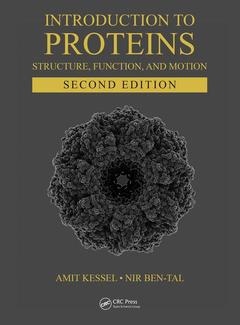Description
Introduction to Proteins (2nd Ed.)
Structure, Function, and Motion, Second Edition
Chapman & Hall/CRC Computational Biology Series
Language: English
Subjects for Introduction to Proteins:
Keywords
structural biology; structural bioinformatics; protein biochemistry; protein biophysics; enzyme kinetics; drug design; PDB Entry; Peptidyl Prolyl Cis-trans Isomerase; PPI; PPII Helix; Nonpolar Residues; Substrate's Transition State; Van Der Waals; ATP Molecule; Allosteric Drugs; Binding Interface; Globular Proteins; SH3 Domain; Structure Prediction; Mis-folded Proteins; Ionic Lock; Transmembrane Segments; Fg Nucleoporins; NPC Component; Enzymatic Catalysis; Binding Site; Acid Base Catalysis; Protein Ligand Binding; MWC Model; Backbone Hydrogen Bonds; Rossmann Fold
· 21x28 cm · Hardback
Description
/li>Contents
/li>Biography
/li>
Introduction to Proteins provides a comprehensive and state-of-the-art introduction to the structure, function, and motion of proteins for students, faculty, and researchers at all levels. The book covers proteins and enzymes across a wide range of contexts and applications, including medical disorders, drugs, toxins, chemical warfare, and animal behavior. Each chapter includes a Summary, Exercises, and References.
New features in the thoroughly-updated second edition include:
- A brand-new chapter on enzymatic catalysis, describing enzyme biochemistry, classification, kinetics, thermodynamics, mechanisms, and applications in medicine and other industries. These are accompanied by multiple animations of biochemical reactions and mechanisms, accessible via embedded QR codes (which can be viewed by smartphones)
- An in-depth discussion of G-protein-coupled receptors (GPCRs)
- A wider-scale description of biochemical and biophysical methods for studying proteins, including fully accessible internet-based resources, such as databases and algorithms
- Animations of protein dynamics and conformational changes, accessible via embedded QR codes
Additional features
- Extensive discussion of the energetics of protein folding, stability and interactions
- A comprehensive view of membrane proteins, with emphasis on structure-function relationship
- Coverage of intrinsically unstructured proteins, providing a complete, realistic view of the proteome and its underlying functions
- Exploration of industrial applications of protein engineering and rational drug design
- Each chapter includes a Summary, Exercies, and References
- Approximately 300 color images
- Downloadable solutions manual available at www.crcpress.com
For more information, including all presentations, tables, animations, and exercises, as well as a complete teaching course on proteins' structure and function, please visit the author's website.
Praise for the first edition
"This book captures, in a very accessible way, a growing body of literature on the structure, function and motion of proteins. This is a superb publication that would be very useful to undergraduates, graduate students, postdoctoral researchers, and instructors involved in structural biology or biophysics courses or in research on protein structure-function relationships." --David Sheehan, ChemBioChem, 2011
"Introduction to Proteins is an excellent, state-of-the-art choice for students, faculty, or researchers needing a monograph on protein structure. This is an immensely informative, thoroughly researched, up-to-date text, with broad coverage and remarkable depth. Introduction to Proteins would provide an excellent basis for an upper-level or graduate course on protein structure, and a valuable addition to the libraries of professionals interested in this centrally important field." --Eric Martz, Biochemistry and Molecular Biology Education, 2012
Introduction. Protein Structure. Methods of Structure Determination and Prediction. Energetics and Protein Stability. Protein Dynamics. Intrinsically Unstructured Proteins. Membrane-Bound Proteins. Protein-Ligand Interactions. Enzymatic Catalysis
Dr. Amit Kessel co-founded and headed the R&D department of ES-IS Technologies, which designs novel enzymatic solutions for the pharmaceutical industry. He studied and trained at Tel-Aviv University and Columbia University, and is currently involved in several academic and industrial biotech initiatives, focusing on experimentally-guided protein structure prediction and on the in-vitro construction of protein-based nanoparticles.
Professor Nir Ben-Tal is based in the Department of Biochemistry and Molecular Biology at Tel Aviv University. His lab has predicted the 3-D structures of numerous transmembrane proteins, providing molecular insight into their mechanisms, and has also developed the ConSurf web-server for the detection of functional regions by mapping evolutionary data onto protein structures (jointly with the Mayrose and Pupko labs). He studied and trained at the Hebrew University, the Technion, Israel Institute of Technology, and Columbia University.
These books may interest you

ProteinsConcepts in Biochemistry 78.51 €



